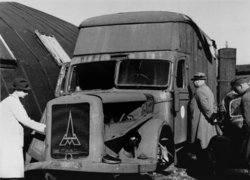Chełmno - The First Death Camp
Chełmno - The First Death Camp
Chełmno - The First Death Camp
Chełmno (Kulmhof) death camp began its orgy of murder on 08 December 1941. The camp itself was situated some forty miles north-west of the Polish city of Łódź, which was located within the newly annexed area known as the ‘Reichsgau Wartheland’. It was the first camp that was specifically designed to be a sort of abattoir, but instead of slaughtering cattle, it slaughtered human beings en masse, men, women and children of all ages were it it's fodder. It's first victims, some 700 Jews from the nearby Polish town of Kolo were loaded in batches of 80 into small gas chambers, which were simply the backs of sealed vans (the camp had three such vans), once loaded, the vans would then travel a short distance to a small wooded area where mass graves had been prepared. Those locked inside the back of the van would be gassed on route using the exhaust fumes from the vehicle itself. Later, the van would remain static as the gassing took place. The area surrounding Chełmno would be combed for Jews and all would suffer the same fate as the Jews from Kolo. Some 88 children from Lidice (Czech village massacre) would also end their lives within the death camp.
The camp's first commandant was SS-Sturmbannführer (Major) Herbert Lange who would later be killed in action on 20 April 1945 within Bernau bei, a small town some 6 miles northeast of Berlin. The camp's last commandant was SS-Hauptsturmführer (Captain) Hans Bothmann who took over in 1942.
In March 1943, the camp stopped its operations and the SS began to dismantle the site, however, when the decision was made to completely liquidate the ghetto at Łódź, the camp was reopened in April 1944 and the killing began all over again in June the same year as transports began to pour in, by this stage the camp had established a crematorium to ensure that all its victims would be cremated.
In September 1944, the camp authorities, as part of 'Sonderaktion 1005' (an operation designed to hide nazi atrocities) began a systematic attempt to cover their crimes. The SS employed a special prisoner Kommando known as 'Leichenkommandos' (corpse units) to exhume all the victims that had been buried and ensure their cremation. In an addition to the process of concealing the crime of genocide, the camp authorities had purchased a bone-crushing machine (Knochenmühle) to ensure no trace of those cremated could be found. When the process had been achieved, the small group of Jews who had formed the corpse unit realised that their time had come, so instead of allowing themselves to be massacred, they staged a revolt. Out of the 48 prisoners that made up the Kommando, only three managed to escape.
It is difficult to ascertain the exact numbers of those murdered within the camp, the estimates are between *170,000 to 360.000 (* Sources for numbers: https://www.britannica.com/place/Chelmno-concentration-camp-Poland and Second World War (2000) Martin Gilbert p274-75). Through the short life of the camp, only a handful of prisoners had managed to escape and by the time the Red Army had arrived at the camp on 17 January 1945, the Nazis had destroyed the site in an attempt to hide the evidence of their crimes, and murdered the remaining prisoners.
Above: A Gas Van
Herbert Lange - Chelmo Commandant.
Born in Menzlin, Pomerania, Lange studied law, but failed to obtain a degree. He joined the NSDAP (Nazi Party) on 01 May 1932. He enlisted in the Sturmabteilung (SA) in August of the same year, and the following year he joined the SS. He subsequently joined the police force becoming a deputy commissioner in 1935.
On November 9 1939, he was promoted to the rank of SS-Untersturmführer (2nd Lieutenant) and was posted in Poland. After his promotion to SS-Obersturmführer (1st Lieutenant) on April 20, 1940, he became the first commandant of Chełmno extermination camp, being implicated in thousands of gassings.
In 1942, his services were needed at the Reich Main Security Office and he was transferred. He served under Arthur Nebe as a Kriminalrat (detective chief superintendent) and in 1944 he aided in catching the conspirators of the attempt on Hitler's life, leading to his promotion to SS-Sturmbannführer.
Lange was killed in action during the Battle of Berlin.

_250x250.jpg)